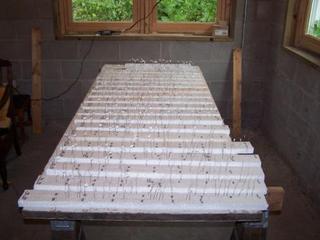|
|
Happily I am back in the Kensington Town Hall- all is well.
For the new in the crew – I teach 9-12 science at Great Plains Lutheran High in Watertown, SD. It is just over a 130 miles away. I am on my 2nd summer at Team Echinacea and will be here Mondays and Tuesdays (typically) to help the project and work on my own investigations.
I am amazed at the difference between the stages of growth throughout the several remnants and the SPP (Staffanson Prairie Preserve) this year compared to last. I would venture it is about 2-3 weeks farther along than it was last year at this time. It is different to see SPP without being burned this spring. The Hjelm house is seeing improvements as well.
GREG
I received the camera today so I had to test it out since the opportunity presented itself. The picture is taken through a stereomicroscope at 45x magnification of a live amphipod from the Big Sioux River. On a qualitative stream survey, we found our water to be very clean. So the camera isn’t just for live pollen anymore. School is going well. I find myself saying “protocol” instead of lab instructions sometimes. Must be a remnant from the prairie.
Hello,
I made it to the fourth day of school without taking my class outside to the nearest prairie remnant (the hill above the river in town)
It took very little time for them to learn to recognize ech. deadheads and rosa arkansana (rose hips). Some were even able to find basal ech. plants. (without offering 6-packs of pop as bait)
 
Here are the data on the three pollen types and the protocol for measuring.
I used the same plant/pollen from each plant and measured at least 30 different pollen grains from each. I didn’t use any pollen if its pole faced forward – only if it was sideways.
Bad news – the Ech. ang. and Heli. heli. are very close. Good news – maybe the pollinators and plants can’t tell them apart either.
Book1.xlsx
PS – I am in SE Minn and the Monarda Sunflower and Miss. Goldenrod are in full bloom all over.
Protocol for slide image recording and measuring.docx
Until I get the website done, this list of measurements is all I can offer you. The measurements are in pixels. The measurements were made from multiple pollen on a single slide.Slide list.xls
Perplexed by Stuart’s question – a trip to the hilltop here in Watertown, and Mimi’s poster, I checked again on the amorpha pollen – it is NOT bean shaped. But I do have reliable pictures – (Amanda don’t bother getting its pollen tomorrow)
What keeps amorpha and medicago sativa from occupying the same locations? Legume wars underground? Does Andrea have insight?

I am slowly moving up from the basement to rejoin the world at ground level. Thanks to Caroline for the labels – three sets of slides of co-flowering plants of E. ang. are complete. The pictures are waiting to appear online. Meanwhile, succession of the Hjelm house basement table (door) occurs. As a flowering plant replaces another on the prairie, Stipa spartea seeds have replaced the slides.
Can you see a difference between the pictures?
Wouldn’t you like to peg some Stipa and populate the board?
I think Someone (codename: drone or riddler) may offer a 6-pack to the person who fills the last seed in each hole of each styrofoam “board”. It would be more fun than chasing a chipmunk out of the Hjelm house.


This two-part entry includes one observation about pollination that struck me odd. I had a floral head (A) at Loeffler’s corner and as Agopostamas texanus approached – it stopped – flew backwards and away – and visited others nearby (all Echinacea). Did the presence of ants on the head – around the anthers have anything to do with the “I’ll just come back later” actions of the bee? Has anyone else observed a head NOT get visited even though it was ripe with pollen because of the presence of ants?
My second half is simply noting that a calico cat and two large kittens were at the end of the common garden yesterday as I left about 4PM. The mother slunk away and the gold/white kitten watched me while the other kitten mostly white/ some black was trying to consume a chipmunk! Are these cats known to inhabit the area?
This may (tentatively) be the official web presence of the pollen library – I am fairly comfortable using wikispaces and the students in my classes are as well. See if it works and provide any feedback you may have.
pollen.wikispaces.com
Enjoy the weekend.
For those who may find it useful soon. The ppt file (which is large) contains the partial identification key for our usage.
If you look closely, the diameters of the main four (Amanda has found) at this time are marked.
More to come next week.Who’s who.ppt
|
|

-thumb-320x240-10991.jpg)




